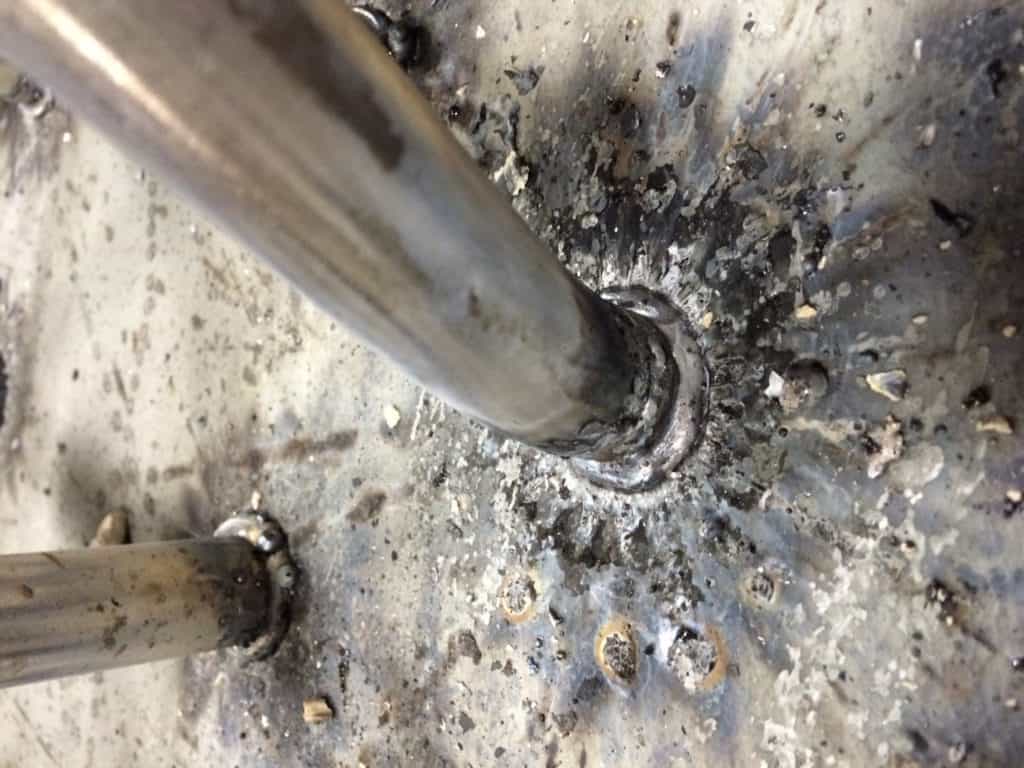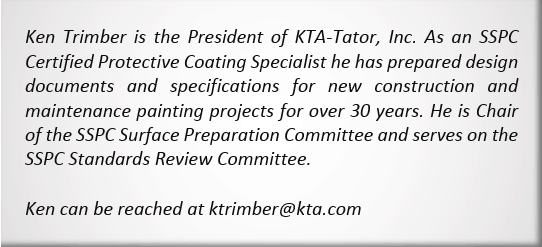When steel is shop-painted, it is usually primed with a zinc coating, and the remaining coat(s)applied to all surfaces except the top of top flanges that will be embedded in concrete. If shear studs will be installed in the top flanges after painting, it is often questioned whether the paint must be removed prior to welding.
Stud manufacturers typically recommend that all paint be removed before shooting studs. Concerns are that the paint can gas up during welding and might extinguish the weld arc. Paint might also contaminate the weld metal and reduce its strength. Some paint could also serve as an insulator, restricting or limiting the area of fusion needed to develop the strength of the studs.
If the zinc primer is organic (e.g., epoxy zinc, moisture cured urethane zinc), it must be removed prior to welding, otherwise, the quality of the weld will be jeopardized as indicated above. However, welding has successfully occurred when inorganic zinc primers are present, without removing them. In fact, some paint manufacturers have specially formulated inorganic zinc primers that reportedly are welded through with no effect on the integrity of the weld. They are promoted as pre-construction primers and are typically applied to a dry film thickness less than 0.8 mil (Figure 1).

While such primers are available, they are typically not used on bridge steel because of the low film thickness. A different, heavier inorganic zinc primer is used in 3-coat bridge paint systems, commonly applied at film thicknesses of 2 to 3.5 mils. With this primer, when stud welding is required, many specifications require the complete removal of the coating prior to welding, while others place restrictions on the film if welding will take place. Restrictions include applying only a mist coat of the primer to the top of the top flanges, or applying a maximum thickness of 1 or 1.5 mils.
The AASHTO/AWS D1.5M/D1.5:2015, Bridge Welding Code states the following in Paragraphs 7.4.2 and 7.4.3:
7.4.2 The stud base shall not be painted, galvanized, nor cadmium-plated prior to welding.
7.4.3 The areas to which the studs are to be welded shall be free of scale, rust, moisture, and other injurious material to the extent necessary to obtain satisfactory welds. These may be cleaned by wire brushing, scaling, prick-punching, or grinding. Extreme care should be exercised when welding through metal decking.
While the Code states that the base of the stud itself is not allowed to have any coating, it does not restrict the presence of paint from the surface the studs are welded to. Even if paint is included under the “other injurious matter” category, based on the text of the Code, it does not have to be removed if satisfactory welds can be achieved. This leaves the door open for welding through a thin coat of weldable zinc, for example.
Assuming there is a desire to install shear studs without removing the inorganic zinc primer, qualification tests should be conducted to validate the approach. Select the desired coating option (e.g. mist coat, film less than 1 mil, etc.), apply the coating to the test surface, allow it to fully cure, shoot the studs, then determine if a satisfactory weld has been achieved (Photo 1). For comparison, it would also be helpful to shoot studs in an area where the zinc was completely removed.

The determination of a satisfactory weld should consist of a visual inspection and a bend test in accordance with the stud application qualification requirements of the applicable welding code. Typically, ten specimens are welded to the base material. A visual examination of the weld is made for evidence of porosity, undercut, cracking and a full 360-degree flash. A bend test is then performed. The bend test involves bending the studs over 90 degrees from their original axis, either by hitting with a hammer or prying over with a pipe or tube (Photo 2).

The test specimens are considered acceptable if fracture occurs in the base material or in the shank of the stud, and not in the weld itself. If the contractor makes any changes to the welding process, base materials, studs or coating, then requalification would be necessary.
Note that even if the welds pass the tests, the following cautions should be considered before making a final decision:
- Since the shear stud manufacturers typically require that paint be removed, deviations from their recommendations should be reconciled. The manufacturer should be included in the tests, and asked to confirm in writing, their acceptance of the approach. If they will not support it, this needs to be considered when making a final decision.
- If it is agreed that the mist coat is suitable for welding, recognize that pinpoint rusting is going to be present on the top flange by the time the steel is erected. A mist coat is not a continuous film, just like a mist of rain does not completely cover your car. There will be specks of exposed steel peppered throughout the mist coat of primer. The exposed steel will rust. Depending on the extent of rusting, the locations where the shear studs will be installed may have to be cleaned (see the excerpt above from the Bridge Welding Code regarding rust). Even if the shear stud can be successfully installed without cleaning, the pinpoint rusting across the top flange is liable to raise concerns regarding the suitability of the paint film for its intended purpose (Photo 3).

- If the tests indicate that a thin film of zinc is acceptable for welding (e.g., less than 1 mil), recognize that it will be extremely difficult for workers to apply a continuous film of zinc that is less than 1 mil in thickness. It is more likely that the quality of the film will range from discrete globules that do not flow together (the mist coat and pinpoint rusting described above) to areas that are heavier than the 1 mil limitation, and potentially much heavier. If the film is too heavy, some or all of the zinc would have to be removed prior to shooting the studs in order to achieve a suitable weld.
- It is highly likely that some of the zinc is going to oxidize by the time the shear studs are installed. The initial tests would have been conducted on fresh unexposed zinc, while the welding will occur on weathered, oxidized, fully cured zinc. It will have to be determined at the time of welding whether any surface cleaning is required.
While the initial testing may show that shear studs can be welded through inorganic zinc, the practical side of achieving a compliant film on a production application basis, together with the effects of weathering should be recognized. In the end, it may be necessary to remove the coating by grinding before shooting the shear studs. Potential deviations from the stud manufacturer’s recommendations when shooting through paint should also be considered.


